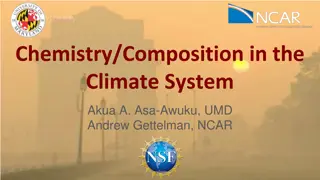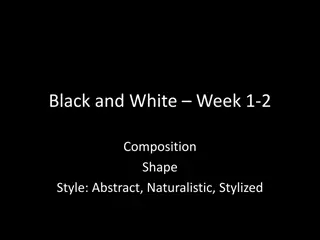Presentation to the Portfolio Committee
Overview of the state of governance in the higher education sector, including key roles, institutional statutes, and the composition of councils. Highlights include the regulations under the Higher Education Act and the publication dates of institutional statutes for various universities. Emphasis i
2 views • 83 slides
Insights into Milk Composition and Processing
Worldwide, milk is collected from various animals such as cows, goats, sheep, yaks, and water buffalo. The composition of milk includes water, lactose, butterfat, protein, and minerals, each playing a vital role in its nutritional value. The butterfat content determines the richness of dairy product
7 views • 41 slides
Overview of PRC Responsibilities
This overview covers the composition and responsibilities of the Program Review Committee (PRC), including membership requirements, election processes, and roles of the PRC Chair. It also touches upon the Library Promotion Committee (LPC) composition and the duties of the PRC Chair within academic i
2 views • 13 slides
Composition of Earth's Oceans
Delve into the composition, location, and subsurface topography of the world's oceans, discovering the chemical makeup of ocean water and its vast salt content. Uncover fascinating facts such as how the salt in the oceans could create a 500-foot thick layer if spread over Earth's land surface. Engag
2 views • 16 slides
Principles of Architecture: Unity, Contrast, Mass Composition
Explore the fundamental principles of architecture focusing on unity, contrast, and mass composition. Unity emphasizes harmony among building elements, contrast adds interest without disrupting unity, and mass composition involves arranging shapes in a harmonious way. Proportion and scale play key r
0 views • 24 slides
Overview of Dental Amalgam: Composition, Uses, Advantages, and Disadvantages
Dental amalgam is an alloy used in dentistry for restorations, consisting of silver, tin, copper, and other metals mixed with liquid mercury. Despite its long history of use due to cost-effectiveness and durability, concerns about aesthetics, toxicity, and environmental impact have led to a decrease
2 views • 22 slides
Effective Strategies for AP Language & Composition Synthesis Essay
Enhance your AP Language & Composition Synthesis Essay scores with tips like focusing on original arguments, considering multiple perspectives, incorporating additional knowledge, avoiding simplistic responses, and using multiple pieces of evidence.
1 views • 19 slides
Atmosphere Composition and Structure in Climatology
The study of climatology, focusing on the atmosphere, is presented by Dr. Banashree Saikia, covering topics such as atmospheric composition, insolation, temperature variations, atmospheric pressure, wind systems, atmospheric moisture, climatic classification, cyclones, and monsoons. The atmosphere,
1 views • 9 slides
Egg: Structure, Composition, and Quality Insights
Egg is a complete food enjoyed worldwide, with hen and duck eggs being popular choices. This article delves into the structure and composition of eggs, highlighting the shell, egg white, and yolk. The shell, comprising calcium carbonate, acts as a protective barrier. Egg white is rich in protein, wh
1 views • 14 slides
Nutritive Value and Composition of Eggs by Dr. Sushma Kumari
The composition and nutritive value of eggs, as presented by Dr. Sushma Kumari from Bihar Animal Sciences University, cover various aspects including the physical composition of eggs, the composition of an eggshell, and the chemical composition of eggs. The presentation delves into details such as t
0 views • 19 slides
Bacterial Cell Structure and Composition Overview
Bacterial cells exhibit variations in size, typically ranging from 0.75 to 1.5 micrometers. The cell envelope, comprising glycocalyx, cell wall, and cell membrane, plays crucial roles in protection and cell function. The cell membrane, a thin barrier rich in phospholipids and proteins, is integral t
2 views • 28 slides
The Composition of Earth's Interior: Insights from Density, Pressure, and Temperature
The constitution of the Earth's interior plays a crucial role in shaping the surface features we observe. Although direct observation is challenging, seismic studies offer valuable insights. The density, pressure, and temperature within the Earth provide essential clues to its composition. Rocks' de
0 views • 14 slides
Asafoetida: Composition, Collection, and Uses in Pharmacognosy
Asafoetida, also known as Gum Asafoetida or Devil's dung, is an oleo-gum resin obtained from Ferula species. It contains trans-ferulic acids and is harvested by incising the roots. The resin is collected, dried, and prepared for commercial use. Asafoetida has a distinct color, odor, and taste, and i
0 views • 24 slides
SERCOM-3 Management Group Composition Proposals 2024-2027
Guidance from Congress and the Executive Council emphasizes the need for balanced representation in leadership positions of technical commissions, focusing on regional, gender, and developmental levels. Proposals for the SERCOM Management Group composition for 2024-2027 include representatives from
3 views • 5 slides
Environmental Hygiene: Air Pollution and Composition of Air
The content delves into the concept of atmospheric pollution, the composition of pure and impure air, sources of air pollution, and the zones of the atmosphere. It highlights the detrimental effects of pollutants on health and the environment, emphasizing the importance of environmental hygiene. The
1 views • 27 slides
Formation and Characteristics of Sedimentary and Metamorphic Rocks
Sedimentary rocks are formed through the aggregation and compaction of sediments, while metamorphic rocks result from changes in the form or composition of existing rocks. Sedimentary rocks contain layers of different sediments and are abundant on Earth's surface, while metamorphic rocks undergo met
1 views • 7 slides
Moles and Formula Mass in Chemistry
Dive into the world of moles, Avogadro's number, and formula mass calculations in chemistry. Learn how to convert moles to grams, grams to moles, and determine the number of atoms using Avogadro's number. Explore the concepts of formula mass and percentage composition to understand the composition o
0 views • 19 slides
Overview of Cement: Types, Composition, and Functions
Cement is a vital building material consisting of various compounds like lime, silica, and alumina. It is used in mortar and concrete. The chemical composition of cement includes elements like iron oxide and gypsum. Different types of cement serve specific purposes such as rapid hardening or sulfate
0 views • 29 slides
Butter: Definition, Standards, and Composition
Explore the definition of butter according to FSSAI standards, including its composition, permitted additives, and classifications based on acidity, salt content, end-use, and manufacturing practices. Discover the nutritional composition and fatty acid profile of butter along with essential informat
0 views • 10 slides
Advanced Composition and Research Course Overview
This advanced composition and introduction to research course focuses on developing students' writing skills, including analysis, synthesis, and evaluation. Through intensive practice, students learn to apply knowledge in various writing contexts, organize information effectively, and make judgments
5 views • 12 slides
National Library of South Africa Overview Presentation 2023
The National Library of South Africa (NLSA) aims to contribute to socio-economic, cultural, educational, scientific, and innovative development by preserving national documentary heritage, fostering information literacy, and providing access to global information resources. The presentation covers t
0 views • 15 slides
Mastering Photographic Composition: Tips and Techniques
Understanding the art of photographic composition is essential for creating visually appealing images. This guide covers key concepts such as simplicity, the rule of thirds, and consideration for moving subjects to help you enhance your photography skills and create compelling pictures.
0 views • 39 slides
Secure Composition of Key Exchange Protocols
Explore the game-based composition approach for key exchange protocols, focusing on ensuring security in compositions with arbitrary tasks and the universal composability of protocols. Delve into the Bellare-Rogaway security model and the details of security games in protocol analysis. Understand ke
0 views • 25 slides
Chemistry and Composition in the Climate System
Dive into the intricate relationship between chemistry and composition in the climate system, exploring topics such as radiative effects, stratosphere-troposphere coupling, aerosol-cloud interactions, and the impact of various gases and particulates on radiative forcing. Discover how changes in comp
0 views • 25 slides
Soil Composition and Importance
Explore the world of soil and its significance as a natural resource by discovering its composition and how it affects plant growth. Learn about the main ingredients of soil, its permeability, and the role of water, air, and organic matter. Gain insights into how soil supports plant life through lea
1 views • 30 slides
Welcome to Mrs. Mike's AP Literature & Composition Class
Mrs. Sacha Mike welcomes students to a new school year in room 113 for AP Literature & Composition. The class mission focuses on excellence in literacy and social success. Students will explore works ranging from dramas to poetry and essays. The class syllabus includes famous works like "Wuthering H
1 views • 26 slides
Cutting-Edge Atmospheric Chemistry Modeling Research at Barcelona Supercomputing Center
Conducted by the Atmospheric Composition Group at Barcelona Supercomputing Center, this cutting-edge research focuses on atmospheric chemistry modeling using advanced tools and frameworks like HERMESv3 and MONARCH. The team's approach integrates various modules to study complex processes influencing
0 views • 16 slides
Comprehensive Guide to Nutritional Value and Composition of Vegetables
Vegetables are herbaceous edible plants cultivated for consumption in various forms like fresh, cooked, or as salads. They are rich in essential nutrients such as protein, carbohydrates, vitamins, and inorganic salts. The tables provided detail the main nutrient constituents and composition of vario
1 views • 25 slides
Fuel Composition Transition Modeling in Two-Stage Recycling Reactors
Modeling the transition of fuel composition in a two-stage recycling reactor scenario poses a unique challenge that previous versions of VISION were unable to address. By tracking fuel mass and isotopics through various stages of the fuel cycle, VISION now enables the modeling of reactors with recip
0 views • 15 slides
Olivine Equilibrium in Calculating Original Magma Composition
The process involves analyzing olivine in basaltic rocks, selecting olivine with the highest Fo content, calculating the melt composition in equilibrium with this olivine using the distribution coefficient (KD), and determining the potential temperature (Tp) based on the MgO content. The distributio
0 views • 30 slides
Soil Chemistry and Mineralogy Analysis at CSU Summer Soil Institute
Explore the comprehensive analysis of soil chemistry, texture, and mineralogy conducted at the CSU Summer Soil Institute in July 2010. The study delves into pedology, elemental composition, particle size distribution, X-ray diffractometry, and mineralogical composition of various soil samples. Detai
0 views • 22 slides
Body Composition: Types, Measurement Methods, and Impacts on Health
Body composition is a key aspect of overall health and fitness. It involves understanding different somatotypes - ectomorph, endomorph, and mesomorph, as well as distinguishing between lean body mass and body fat. Various methods such as underwater weighing, electrical impedance, skinfold measuremen
0 views • 26 slides
The Difference Between Aggregation and Composition in Object-Oriented Programming
Aggregation and Composition are two important concepts in object-oriented programming. Aggregation refers to a 'has-a' relationship where the contained object can survive independently, while Composition indicates that the member object is part of the containing class and cannot exist separately. Th
0 views • 15 slides
Percentage Composition in Chemistry
Percentage composition is crucial in determining the elemental composition of compounds. This lesson explains how to calculate percentage composition using molar masses, illustrated with examples like copper sulfide. It also delves into hydrated salts and their significance in chemistry. Students wi
0 views • 22 slides
Composition in Art: Techniques and Examples
Explore the concept of composition in art through various styles such as abstract, naturalistic, and stylized representations. Learn about the vocabulary and skills necessary for effective composition, with examples from renowned artists like Leonardo da Vinci, Georges Seurat, and more. Discover how
0 views • 43 slides
Impact of Racial/Ethnic Composition on School Security
This study by Tim Servoss at Canisius College explores the relationship between racial/ethnic composition of schools and their security measures. Analyzing data from the 2015-2016 School Survey on Crime and Safety, the research investigates how the percentage of Black and Hispanic students in school
1 views • 11 slides
Factors Affecting Algal Ecology: Light Intensity Impacts on Algae Growth and Composition
Light intensity plays a crucial role in the growth and composition of algae. Algae undergo photoadaptation processes to adjust to varying light levels, affecting their photosynthetic efficiency and cellular properties. High light intensity can lead to photoinhibition and changes in cellular composit
0 views • 19 slides
Aggregation and Composition in Object-Oriented Programming
Aggregation and composition are essential concepts in object-oriented programming, defining relationships between classes and objects. Aggregation allows objects of one class to own objects of another class, while composition represents a stronger relationship where the enclosing class controls the
0 views • 14 slides
Chemical Composition and Generation Rates in Solid Waste Management
Information on the chemical analysis and composition of solid waste is crucial for evaluating alternative processing and recovery options. Key properties include proximate and ultimate analysis, heating value, nutrient value, and future changes in composition. Understanding generation rates involves
0 views • 7 slides
Traffic Composition and Equivalent Passenger Car Units
In civil engineering, understanding traffic composition is essential for capacity estimation. Converting different vehicle classes to equivalent passenger car units aids in assessing roadway capacity accurately. This document discusses the concept of passenger car units, provides a breakdown of vari
0 views • 7 slides







































